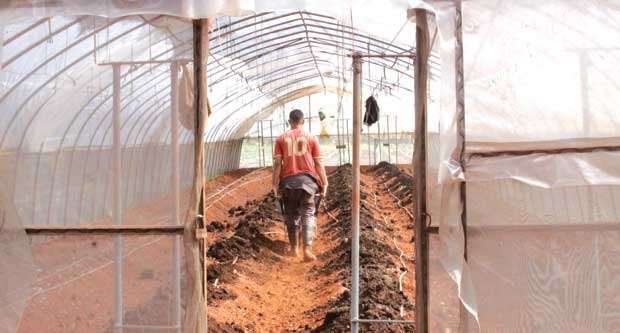Ben Nicholson takes a quick break in the shade and mops his brow with a handkerchief, and then continues wandering the urban garden’s 10.7 hectares. He carries a notebook and wears boots and a hat. It’s hotter here than back home in far-off Chicago, but he keeps a steady pace, jotting down his impressions.
He is a professor of architecture and has an environmental garden. He is interested in urban agriculture and its ties to the community, which is why he has undertaken a trip through more than 20 countries reported to have successful urban agriculture experiences. And that is why he has come to eastern Havana, to the Vivero Alamar organopónico (organic urban garden), a Basic Unit of Cooperative Production (UBPC).
Founded in 1997 by Miguel Salcines, its president since then, this agricultural cooperative provides employment for 180 people from different professional backgrounds who work in its nine cost centers,
areas devoted to a specific productive activity that contributes to the functioning of the rest, forming a system of complementary elements in the productive cycle. These centers include agricultural production, animal breeding, cultivation and sale of ornamental plants and fruit trees, a small industry of derivatives, production and sale of organic material, and marketing the products of the land, among others.
Such a diversity of lines gives the farm commercial stability. This agricultural complex supplies the more than 50,000 people annually who visit its sales outlets. They have hardly any competition. Salcines—who enjoys the support of the coop’s members, because he ensures a sense of collective leadership—says that this is something likely to change, given the new economic situation in Cuba.
However, the Vivero Alamar has an advantage in the areas of agroecology, profitability, and impact on local development. According to Salcines, they practice “21st century agriculture: with science, intelligence, vocation, and financial results; based on agroecological principles and promoting farmers’ participation in every aspect of society.”
The coop’s workers have a seven-hour workday in the winter and a six-hour day in the summer, and earn wages that are 100 pesos more than the Cuban minimum wage (250 Cuban pesos). Moreover, they benefit from a bonus policy that financially reflects their performance on the job and their seniority at the coop: every two weeks, they receive a bonus based on total income for that period. Working better and longer means remuneration, as well as contributing to reconciling individual and collective interest.
The coop’s agroecological approach includes using biodegradable planting bags and insects as biological controls. They use vermiculture to produce cow-manure based organic fertilizer and compost, which come from decomposed vegetable waste from the coop itself, and improve the structure of its soils. They use efficient microorganisms for spraying or for applying as fertilizer: fungi, bacteria, and yeast, which grow in woody areas with plentiful tree sediment, fallen leaves, etc.
It is safe to say that the Vivero Alamar is a leader in environmental protection by reproducing in agriculture the natural processes that spontaneously occur in forests and rain forests, while at the same time delivering high yields and ensuring environmental equilibrium.
“In addition to being a center of production, it becomes a sanatorium. Whoever is here is healthier on the outside and on the inside,” says Medardo, its scientific/technical assistant director.
Isis, one of the coop’s specialists, says she feels “very proud of this place, because it is a paradigm for agriculture in Cuba and for many parts of the world.” Exchange with people from other countries also makes it possible to situate it beyond the national context, and to learn from visitors’ contributions. In fact, Nicholson was one of approximately 400 foreigners who visit the Vivero every week in groups of specialized tourism, academics, farmers, environmentalists, and others.
The Vivero provides many benefits for the community. Martha, for example, mentions the advantages of having access to organic food. “Plus they are fresh, and their prices are lower than in other state markets,” she adds.* Orestes, for his part, praises the variety of products on sale and the service provided, and says he loves the guarapo (fresh sugar cane juice) that the coop makes with the sugar cane that it grows and harvests. “Homemade guarapo,” he says, sipping it in the shade of this green corner of the city.
Tierralismo (Landism), a documentary by Alejandro Ramírez Anderson—who took the photos that accompany this article—is a 52-minute exploration of the design and policies of this urban agricultural cooperative, which has made environmental principles and collective labor its sources of greater efficiency. All of that, captured through beautiful images of this Babylonian garden in the heart of Havana.








